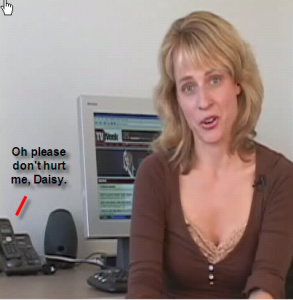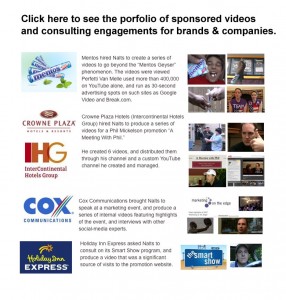Don’t get depressed about the economy folks. Even wrecklessly stupid brands are squeezing old-media spending in favor of paid search, targeted interactive advertising, and … yes… even online video.
Marketing and advertising spend on online video has a good future. Even though it’s a small sliver of online spending and difficult to measure (slicing fog), Uncle Nalts has some ideas for the industry that can help. I’ve even numbered them below, but let’s look at the problem first.
Today’s eMarketer reports that LiveRail (LiveRail is a video ad server, so take this with a grain of salt) estimates 2010 at $1.4 billion, up from a 2008 spend of about $619 million. eMarketer is a bit more conservative (and recently downgraded its forecast), but may not be counting special programs… for instance, it’s hard to measure sponsorships that are unique to a creator or a website. Nonetheless, most agree that online-video represents just 2% of online spending, which is asburdly low. It reminds me of how slow media buyers were to capitalize on paid search in the early 2000s. I need to say that again. It reminds me of how slow media buyers were to capitalize on paid search in the early 2000s.
 Daisy Whitney wrote a nice article summarizing the issues with measuring the online-video advertising. Uncle Nalts spoke to Whitney, but she had tossed her phone in the bathtub before he got his points across… Whitney reports that IAB (Interactive Advertising Bureau – see its blog) likes its methodolgy for capturing spending. IAB measures “digital video commercials” or “TV-like advertisements” that appear before, during or after a variety of content, but not brand integration. “We believe we are capturing the biggest part of a growing market,” said David Doty, senior VP, thought leadership and marketing, at IAB.
Daisy Whitney wrote a nice article summarizing the issues with measuring the online-video advertising. Uncle Nalts spoke to Whitney, but she had tossed her phone in the bathtub before he got his points across… Whitney reports that IAB (Interactive Advertising Bureau – see its blog) likes its methodolgy for capturing spending. IAB measures “digital video commercials” or “TV-like advertisements” that appear before, during or after a variety of content, but not brand integration. “We believe we are capturing the biggest part of a growing market,” said David Doty, senior VP, thought leadership and marketing, at IAB.
 I couldn’t disagree more. By IAB’s definition, I make zero income on online-video advertising. That’s because my YouTube Partner revenue is based on “InVideo” ads that presumably don’t meet IAB’s definition. And certainly the low income CPM-based “display creative” around my videos is not captured in that spend. But as grateful as I am about YouTube sharing advertising revenue, I make far more money through custom videos (aka sponsored videos).
I couldn’t disagree more. By IAB’s definition, I make zero income on online-video advertising. That’s because my YouTube Partner revenue is based on “InVideo” ads that presumably don’t meet IAB’s definition. And certainly the low income CPM-based “display creative” around my videos is not captured in that spend. But as grateful as I am about YouTube sharing advertising revenue, I make far more money through custom videos (aka sponsored videos).
What are sponsored videos? See this page for examples of entertaining videos that have subtle brand messages. My fellow creators do more subtle “product placement” for money, but I haven’t messed with that yet because I fear backlash if I’m not transparent. And I don’t want someone thinking I’m getting paid by Coke if I take a swig in a video. Even though I totally would if my friend Mike at Coke Interactive would throw be a friggin’ bone.
So what do we need to spur further uptake in online-video advertising?
- Measure it more precisely to help brands understand how to allocate their spend, and increase online-video advertising from 2% to something closer to 10%.
- Conduct more studies that show video advertising works — even if it’s surrounding (gasp) amateur or consumer-generated content.
- Encourage experimental marketers who are not only open to new channels, but pressure agencies to identify creative options so they’re not lost in the clutter.
- Reward agencies for exploring new vehicles to reach target consumers when they’re engaged in their experience (and not brain dead on the couch). The inventory is there, folks, but we’re not going to solve the problem by hiring stupid CPM media buyers that are recently graduated, hungover and trying to find a new boyfriend.






